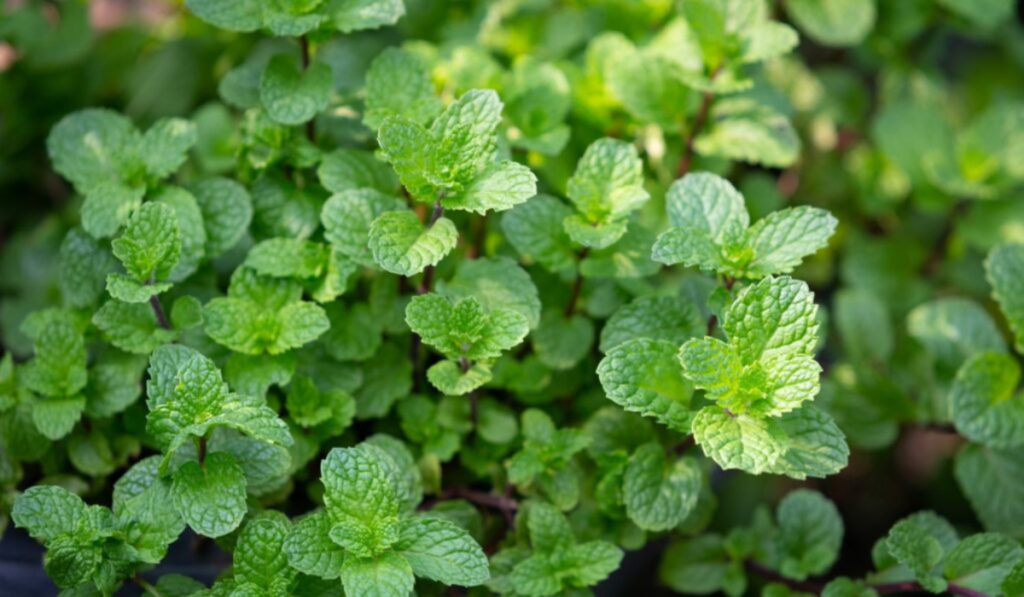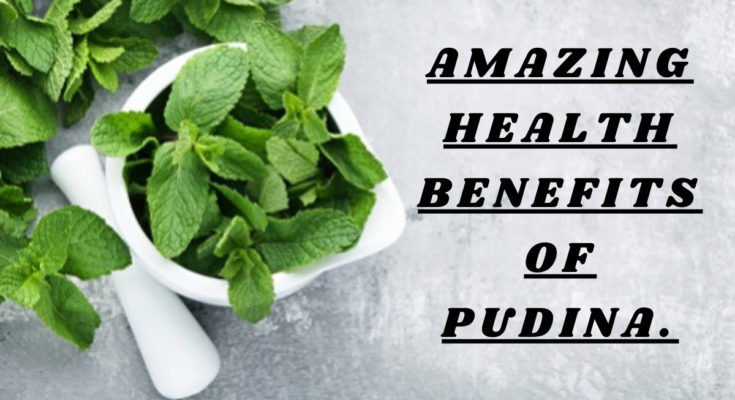PUDINA :-

Pudina is the Hindi and Urdu word for mint, a popular herb known for its refreshing taste and cooling effect. It is commonly used in various cuisines, especially in Indian, Middle Eastern, and Mediterranean dishes. Mint leaves are also used to make tea, chutneys, and sauces, and are added to salads and soups as a garnish.
Mint is not only valued for its culinary properties but also for its medicinal benefits. It is believed to aid digestion, relieve nausea, and reduce inflammation. Mint essential oil is also used in aromatherapy for its calming and relaxing effects.
Overall, pudina or mint is a versatile and useful herb that adds flavor and health benefits to various dishes and products.
MEDICINAL PROPERTIES :-
Mint, also known as pudina, has several medicinal properties that have been studied and documented over the years. Here are some of the common medicinal properties of mint:
1. Digestive Aid: Mint is known to aid in digestion and relieve digestive issues such as bloating, gas, and indigestion. It is also believed to stimulate the production of digestive enzymes in the stomach.
2. Anti-inflammatory: Mint has anti-inflammatory properties that can help reduce inflammation in the body, making it helpful for conditions like rheumatoid arthritis, asthma, and allergies.
3. Pain Relief: Mint has a cooling effect on the skin and can help relieve pain and discomfort associated with headaches, muscle aches, and menstrual cramps.
4. Respiratory Health: Mint is believed to help improve respiratory health by relieving congestion and opening up the airways. It is also used in many cough and cold remedies.
5. Oral Health: Mint has antibacterial properties that can help prevent bad breath and gum disease. It is also commonly used in toothpaste and mouthwash.
6. Stress Relief: The aroma of mint has a calming effect and is believed to help reduce stress and anxiety.
Overall, mint or pudina has several medicinal properties that make it a popular herb for various health conditions. However, it is important to note that while mint is generally considered safe, it may interact with certain medications and should be used in moderation. It is always best to consult with a healthcare provider before using any herbal remedies.
USES :-
Mint, or pudina, can be used in several ways, including:
1. Culinary Uses: Mint is widely used in cooking and can be added to a variety of dishes, such as salads, soups, sauces, chutneys, and drinks like tea or lemonade. It can be used fresh or dried and adds a refreshing and minty flavor to the dish.
2. Aromatherapy: Mint essential oil is often used in aromatherapy to promote relaxation and reduce stress. You can use a diffuser to disperse the mint oil into the air or add a few drops to a warm bath.
3. Topical Application: Mint leaves or essential oil can be used topically to relieve pain and inflammation. You can crush fresh mint leaves and apply them to the affected area or mix a few drops of mint oil with a carrier oil like coconut oil and massage onto the skin.
4. Herbal Tea: Mint tea is a popular beverage that is easy to make at home. You can steep fresh or dried mint leaves in hot water for a few minutes and add honey or lemon for flavor.
5. Mouthwash: Mint leaves can be boiled in water and used as a mouthwash to freshen breath and promote oral health.
It’s important to note that while mint is generally safe, some people may be allergic to it, and excessive use of mint or mint oil can cause side effects like skin irritation, digestive problems, or even respiratory issues. Always use mint in moderation and consult with a healthcare provider before using any herbal remedies, especially if you have any medical conditions or are taking any medications.
NUTRITIONAL VALUE :-
Mint or pudina is a herb that has several nutritional benefits. Although it is usually consumed in small quantities, it contains vitamins, minerals, and other nutrients that can contribute to a healthy diet. Here are some of the key nutritional benefits of mint:
Vitamins: Mint contains vitamins A, C, and E, which are essential for good vision, healthy skin, and a strong immune system.
Minerals: Mint is a good source of minerals such as calcium, magnesium, and potassium. These minerals help build strong bones and regulate blood pressure.
Antioxidants: Mint contains several antioxidants, such as rosmarinic acid and flavonoids, that help protect the body from oxidative stress and reduce inflammation.
Fiber: Mint contains a small amount of dietary fiber, which is important for digestive health and helps regulate blood sugar levels.
Essentials Oils: Mint contains essential oils such as menthol, which gives it a refreshing taste and also has antiseptic and antibacterial properties.
Overall, while mint is not a significant source of any one nutrient, it can contribute to a healthy and balanced diet when consumed as part of a varied diet.
Here is the nutritional breakdown of 100 grams of fresh mint leaves:
- Calories: 70 kcal
- Protein: 3.75 g
- Fat: 0.94 g
- Carbohydrates: 14.89 g
- Fiber: 8 g
- Sugars: 0 g
- Calcium: 243 mg
- Iron: 5.92 mg
- Magnesium: 80 mg
- Phosphorus: 73 mg
- Potassium: 569 mg
- Sodium: 31 mg
- Vitamin C: 31.8 mg
- Vitamin A: 5693 IU
It’s important to note that the nutritional value of dried mint may differ from that of fresh mint, as some of the nutrients may be lost during the drying process. Additionally, the nutritional value may vary depending on the growing conditions, harvesting methods, and other factors. Nevertheless, fresh mint is a good source of fiber, vitamins, and minerals, especially calcium, iron, and vitamin A.



